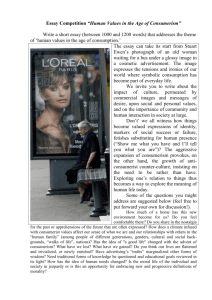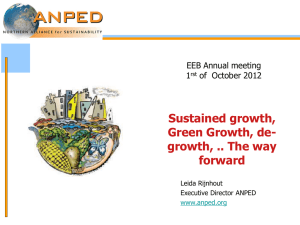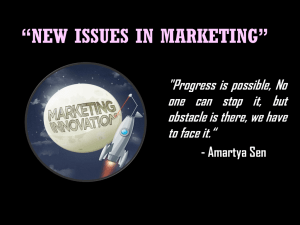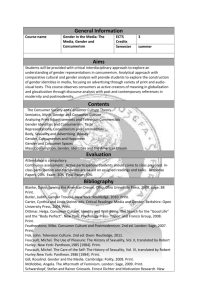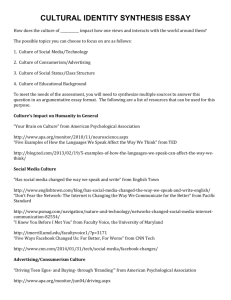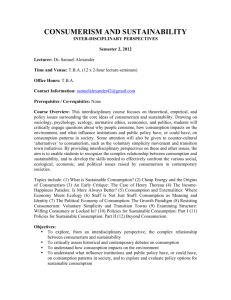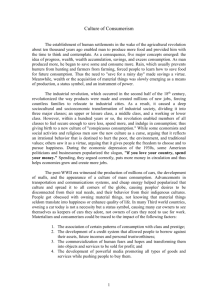Final question--write about 10-12 pages on the question below
advertisement
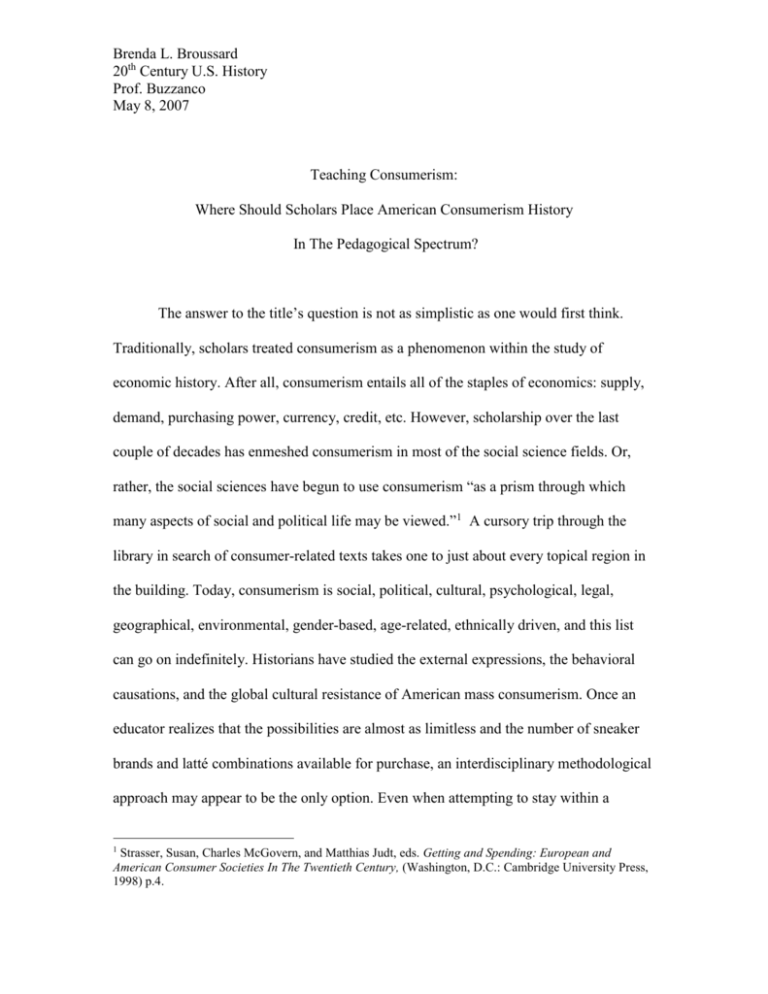
Brenda L. Broussard 20th Century U.S. History Prof. Buzzanco May 8, 2007 Teaching Consumerism: Where Should Scholars Place American Consumerism History In The Pedagogical Spectrum? The answer to the title’s question is not as simplistic as one would first think. Traditionally, scholars treated consumerism as a phenomenon within the study of economic history. After all, consumerism entails all of the staples of economics: supply, demand, purchasing power, currency, credit, etc. However, scholarship over the last couple of decades has enmeshed consumerism in most of the social science fields. Or, rather, the social sciences have begun to use consumerism “as a prism through which many aspects of social and political life may be viewed.”1 A cursory trip through the library in search of consumer-related texts takes one to just about every topical region in the building. Today, consumerism is social, political, cultural, psychological, legal, geographical, environmental, gender-based, age-related, ethnically driven, and this list can go on indefinitely. Historians have studied the external expressions, the behavioral causations, and the global cultural resistance of American mass consumerism. Once an educator realizes that the possibilities are almost as limitless and the number of sneaker brands and latté combinations available for purchase, an interdisciplinary methodological approach may appear to be the only option. Even when attempting to stay within a 1 Strasser, Susan, Charles McGovern, and Matthias Judt, eds. Getting and Spending: European and American Consumer Societies In The Twentieth Century, (Washington, D.C.: Cambridge University Press, 1998) p.4. Broussard 2 particular discipline, it soon becomes apparent that consumerism cannot be withdrawn from the sum of its parts. On the other hand, the task of including all disciplines at once in a project is equally as daunting. The solution may lie in awarding the study of consumerism the right to be a field of its own. However, for the purpose of this study, this essay will interpret consumerism history by examining those approaches that scholars have most recently employed and discuss how best to incorporate certain disciplines into an American history survey course. Political Approaches Recent trends in political history expose the convoluted correlation between consumerism, state politics, democratic ideology, and definitions of citizenship. Many scholars postulate that consumption is “synonymous with citizenship” and democracy.2 Relaying the politics of consumerism to students requires some fleshing out of the invisible and often censored processes of production, distribution, and consumption. Recent grassroots activities against capitalist giants like Wal-Mart and Starbucks brings some light to the politics of consumerism when examining the methods these corporations use to bring cheap products to the consumer and how laws are manipulatively interpreted by corporate lawyers to protect the interest of the business over that of the worker and consumer. Consumers react to news of child labor in sweatshops and ecological destruction by staging boycotts and appealing to their congressional representatives to pass laws to end the corporate abuses. Corporate lobbyists additionally appeal to the government with promises of renewed economic growth in depressed local economies in exchange for relaxed environmental policies or 2 Ibid., p.11. Broussard 3 generous tax relief. This triadic relationship between business, citizen, and government demands that consumerism be examined as a powerful political force. Several very recent texts demonstrate the politicization of consumerism. Michelle Micheletti’s Political Virtue and Shopping explains how consumerism influences governance, laws, and regulatory tools as well as examines direct and indirect consumer political involvement. Micheletti credits globalization and technological advances such as the internet for the anomaly of consumer politics (she also acknowledges that there are different views of the conception of the consumerism and politics link)3. Micheletti’s text not only deals with the theoretical constructs of political consumerism, but additionally explains how “actions by individuals and groups in common everyday circumstances like shopping daily for one’s family or oneself can matter significantly.”4 This approach illuminates the correlation between globalization and consumer politics. Examples of boycotts and selective shopping concerning such tangible icons as Nike, McDonalds, and Target appeal to the student of today due to their relativity. While Micheletti’s study deals primarily with the last thirty years of consumerism, Lizbeth Cohen focuses on the grassroots movements of political policies for consumers from the Progressive era to the end of WWII in A Consumer’s Republic.5 She concentrates on the role women and African-Americans had in changing policies in the first part of her text. Cohen’s second section discusses the emergence of the Postwar Consumers’ Republic. She uses examples of advertising that stressed how spending not 3 Micheletti, Michele. Political Virtue and Shopping: Individuals, Consumerism, and Collective Action, (New York: Palgrave MacMillan, 2003) p. xi. 4 5 Ibid., p. 15. Cohen, Lizbeth. A Consumers' Republic: The Politics Of Mass Consumption In Postwar America, (New York: Alfred A. Knopf, 2003). Broussard 4 only improved one’s immediate condition, it was also a civic duty to spend as much as possible to fuel the economy and thus benefit all Americans and raise all families’ living conditions. Hording was un-American. Cohen explores the battle between conservatives and liberals in achieving the same outcome, but with different approaches in government policy. One area that all interests appeared to support was small “complementary defense spending” to help fuel both consumer and military Keynesianism.6 Cohen’s study furthers the citizenship and democracy theme by citing numerous examples of government propaganda to encourage spending in the private sector to help fight communism. This is a popular, repeated, and sometimes controversial theme in recent discourses attempting to explain the emergence of consumerism. Political approaches tend to credit institutions for creating consumers, while cultural studies see consumerism as a product of shifting human behaviors. Robert Collins additionally deals with the formation of an American ideology that “the consumer culture was America and vice versa” in his 2000 book, More: The Politics of Economic Growth in Postwar America.7 Kathryn Kish Sklar has published numerous articles and conference papers in anthologies, journals, and on her website dealing with particular instances of consumers using their buying power to alter the system. While her focus is primarily on the power of women, her studies exemplify grassroots victories in human rights, equal rights, and labor laws. Another recent book, Getting and Spending, is broken down into three parts, the first of which is a compilation of essays dealing entirely 6 7 Ibid., p. 118. Collins, Robert. More: The Politics of Economic Growth in Postwar America, (New York: Oxford University Press, 2000), p. 16. Broussard 5 with the politics of consumerism.8 The short essays provide an excellent tool for an instructor to use to emphasize the concepts of political agency by consumers and of citizen-consumers. Overall, the recent political studies of consumerism argue that the shift to mass consumerism redefined gender roles, reshaped class politics, benefited the civil rights movement, altered residential landscapes, and ultimately determined political policy from the local level to the global realm. Taking the political approach provides instructors a means of teaching institutional history from a private point of view: that of the everyday shopper. Cultural/social approaches Cultural and social approaches to consumerism are by far the most popular at the start of the twenty-first century. While distinguishable among cultural studies academics and sociologists, the difference between the two approaches is quite often so imperceptible, that for the sake of convenience they will be lumped together in this essay. Two distinguishing features to note on the different approaches however are: social historians are most willing to practice “interdisciplinary cross-pollination” in their discourses of consumerism. 9 Whereas, according to Tom Frank, cultural historians and other “’cult studs’ (cultural studies academics)” tend to “see audience ‘agency’ lurking in every consumer decision….[and] find seeds of rebellion and resistance in almost any of the culture-products….”10 This translates to cultural studies appearing more cynical of the 8 See Strasser, et al. Stearns, Peter N. “Social History Update: Encountering Postmodernism,” Journal of Social History, Vol. 24, No. 2. (Winter, 1990), p. 450. 9 10 Frank, Thomas. New Consensus For Old: Cultural Studies From Left To Right,. (Chicago: Prickly Paradigm Press, 2002), pp. 6-7. Broussard 6 governing institutions and more apt to give a conspiratorial twist to the outcomes while social approaches appear to maintain a higher level of objectivity. Most scholarship, even the cynical scholarship, is moving away from demonizing institutions and the market (i.e. Wall Street) and taking a more objective stance on the big business vs. little shopper theme. In any case, the historian recognizes quickly how enmeshed culture, society, and consumerism are with one another. Daniel Wickberg also points out that, “The cultural historian of economic life is struck by the extent to which moral and economic vocabularies overlap in modern America: credit, value, trust, worth, earning, productivity are not merely economic terms, but moral ones; they are not merely descriptive and quantitative, but normative and qualitative as well.”11 With such a moral lexicon as the bases of consumerism, it is no wonder why so many studies have taken the social/cultural approach. The amount of cultural/social texts that deal with consumerism and aspects of consumerism is overwhelming. Texts deal with specific areas such as food, fashion, housing, health, and entertainment.12 If you can purchase the item or the service, then most likely you can find a book written on the consumer aspect of it. The commodification of the human body, both as a sexual object and as “parts for sale” (organ donations and surrogacy) demonstrate just how far consumerism as gone. There literally is no aspect of human life that consumerism does not play a part in and the Wickberg, Daniel. “The Iron Cage of Credit,” Reviews in American History, (March, 2000), p.81. Project Muse, online resource accessed at <http://muse.jhu.edu> on April 22, 2007. 11 12 Some instances are: Belasco, Warren and Phillip Scranton, eds. Food Nations: Selling Taste in Consumer Societies, (New York: Routledge, 2002); Schlosser, Eric, Fast Food Nation: The Dark Side of the AllAmerican Meal, (Boston: Houghton Mifflin, 2001). Broussard 7 numerous studies available today explore the multitude of ways that Americans are living the “American Dream” of a house, two cars, two kids, a dog, cat, etc. Lendol Calder takes a slightly different stance on consumerism by examining the means by which all this mass consumption is even possible for most Americans. His cultural study, Financing the American Dream not only shows the evolution of credit financing, but also by examining the period between 1870 and 1940 ( the decades presumably prior to the “Era of Mass Consumption”), Calder debunks the myth that credit purchasing is a new phenomenon.13 Calder’s most persuasive argument is how installment plans actually created worker discipline by tying the employee to the job. Workers simply cannot afford to quit their jobs as long as they are in debt to creditors.14 A final cultural approach that is popular teaching at the moment concerns the subject of resistance of American-style consumerism. Scholars are exploring this area both internally and externally. Tom Frank, Joseph Heath, and Andrew Potter explore the resistance of mass consumerism and fads by the countercultures and how their choices of resistance in turn become a form of consumer culture.15 The external resistance studies deal with differing ideologies on a global scale, primarily with (but not limited to) the Islamic faith. Benjamin R. Barber’s Jihad vs. McWorld and George Ritzer’s The McDonaldization of Society take on the issue of globalization, its synonymy with “Americanization” and American consumerism, and the cultural backlashes from non- 13 Calder, Lendol. Financing the American Dream: A cultural History of Consumer Credit. (Princeton, NJ: Princeton University Press, 1999). 14 15 Ibid., p. 156. Frank, Thomas. The Conquest of Cool: Business Culture, Counterculture, and the Rise of Hip Consumerism, (Chicago: University of Chicago Press, 1998); Heath, Joseph and Andrew Potter. Nation of Rebels: Why Counterculture Became Consumer Culture, (New York: HarperCollins Publishers Inc., 2004). Broussard 8 Western societies. Some terrorist actions are manifestations of the resistance to American consumerism driven by Islamic ideologies condemning westernization. These studies are particularly pertinent to advance the understanding of the current worldly sympathies toward both economic belief systems (capitalism and anti-materialism). Not all resistance is from Islamic nations. Douglas J. Goodman and Mirell Cohen discuss Anti-Americanization in their reference on consumerism, Consumer Culture. They argue, “the spread of consumer culture is supported by the rejection of consumer culture represented as Americanization.”16 Essentially, this means that whenever a group or individual refuses to buy into the mainstream of Americanization by purchasing a product less Americanized (i.e. buy McWonTon instead of a Big Mac), consumption is still occurring and therefore, mass consumption as a culture continues to spread. People’s “dissatisfaction with the culture is expressed through more consumption.”17 This vicious little cycle has become a social problem without a solution for some societies. Resistance exists domestically also. As Ann Smart Martin points out, by the 1990s, consumerism emerged in the health and psychological fields as a condition similar to drug abuse.18 Health and mental care providers began dealing with addictions of shopping and acquisition of things. Purchasing emerged as a social crutch or substitute for love. Seeking out help for these conditions even fueled consumerism with a flurry of self-help books and support organizations cropping up. 16 Goodman, Douglas J. and Mirelle Cohen. Consumer Culture: A Reference Handbook, (Santa Barbara, CA: ABC-CLIO, Inc., 2004, p. 69). 17 Ibid., p.70. Martin, Ann Smart. “Makers, Buyers, and Users: Consumerism as a Material Culture Framework,” Winterthur Portfolio, Vol. 28, No. 2/3. (Summer - Autumn, 1993), pp. 141-157. 18 Broussard 9 Cultural/social approaches in consumerism can be fun and shocking in the classroom. Responses by students are often the sudden realization of the machinations of systems they have taken for granted. Economic Approaches Certainly not as popular as the cultural/social or political approaches, the economic approach to consumerism still exists. A general overview of the mechanics of consumptive patterns is Angus Deaton’s Understanding Consumption. Another recent economic text that is less dry (and less quantitative and empirical) is Richard Robbins’ Global problems and the Culture of Capitalism. Robbins’ work links the culture of capitalism to the worldwide ailments of poverty, disease, and social hierarchy. Empirical data can be useful in the instructional setting, but usually not as attention getting as the other approaches. Whichever approach, or combination of approaches, an instructor chooses to employ for consumerism, students should realize that no aspect of human life is untouched by modern consumerism. A good exercise for the students would be to challenge them to name an area of life not affected by consumerism. Sterns exemplifies this by pointing out how certain changes in human behavior have led to consumerism. He points to the health industry.19 Once cures for ailments were treated with home remedies, then snake oil peddlers and charlatans pushed their miraculous cures-in-a-bottle which led to a demand for scientific medicine and finally to the highly competitive healthcare industry (to include the diet and vanity-health industries) of today. Sterns also points out how changes in courtship “helped further acquisition; clothes… even perfumes made Stearns, Peter N. “Stages of consumerism: Recent Work on the Issues of Periodization,” The Journal of Modern History, Vol. 69, No. 1. (Mar., 1997), pp. 106-107. 19 Broussard 10 more sense when one was trying to elicit a positive response from a prospective mate rather than relying primarily on parental arrangement of marriage. The rise of dating…[meant that there] was the need for a couple to develop a relationship while buying entertainment, food, or other items.”20 Even the act of desiring to consume is a behavioral trait that fuels consumerism. In other words, people shop as a form of entertainment, pleasure, and self-gratification. The act of shopping fulfils as much of an emotional need as the consumption of goods may fulfill a physical need. Therefore, consumerism plays an enormous role in society and deserves an active part in the study of American history. 20 Ibid., pp. 108, 112. Broussard 11 Bibliography Belasco, Warren and Phillip Scranton, eds. Food Nations: Selling Taste in Consumer Societies. New York: Routledge, 2002. Calder, Lendol. Financing the American Dream: A cultural History of Consumer Credit. Princeton, NJ: Princeton University Press, 1999. Collins, Robert. More: The Politics of Economic Growth in Postwar America. New York: Oxford University Press, 2000. Cohen, Lizbeth. A Consumers' Republic: The Politics Of Mass Consumption In Postwar America, New York: Alfred A. Knopf, 2003. Deaton, Angus. Understanding Consumption. Oxford: Oxford University Press, 1992. Frank, Thomas. The Conquest of Cool: Business Culture, Counterculture, and the Rise of Hip Consumerism. Chicago: University of Chicago Press, 1998. -----. New Consensus For Old: Cultural Studies From Left To Right. Chicago: Prickly Paradigm Press, 2002. -----. One Market Under God: Extreme Capitalism, Market Populism, and the End of Economic Democracy. New York: Doubleday, 2000. Goodman, Douglas J. and Mirelle Cohen. Consumer Culture: A Reference Handbook. Santa Barbara, CA: ABC-CLIO, Inc., 2004. Heath, Joseph and Andrew Potter. Nation of Rebels: Why Counterculture Became Consumer Culture. New York: HarperCollins Publishers Inc., 2004. Martin, Ann Smart. “Makers, Buyers, and Users: Consumerism as a Material Culture Framework,” Winterthur Portfolio, Vol. 28, No. 2/3. (Summer - Autumn, 1993), pp. 141-157. Accessed <www.jstor.org> April 16, 2007. Micheletti, Michele. Political Virtue and Shopping: Individuals, Consumerism, and Collective Action. New York: Palgrave MacMillan, 2003. Robbins, Richard. Global Problems and the Culture of Capitalism. Boston: Allyn and Bacon, 2002. Schlosser, Eric, Fast Food Nation: The Dark Side of the All-American Meal, Boston: Houghton Mifflin, 2001. Broussard 12 Stearns, Peter N. “Social History Update: Encountering Postmodernism,” Journal of Social History, Vol. 24, No. 2. (Winter, 1990), pp. 449-452. Accessed <www.jstor.org> April 30, 2007. -----.“Stages of consumerism: Recent Work on the Issues of Periodization,” The Journal of Modern History, Vol. 69, No. 1. (Mar. 1997), pp. 102-117. Accessed <www.jstor.org> April 30, 2007. Strasser, Susan, Charles McGovern, and Matthias Judt, eds. Getting and Spending: European and American Consumer Societies In The Twentieth Century. Washington, D.C.: Cambridge University Press, 1998. Wickberg, Daniel. “The Iron Cage of Credit,” Reviews in American History, (March, 2000), pp. 79-86. Supplied by Project Muse, online resource accessed at <http://muse.jhu.edu> on April 22, 2007.
